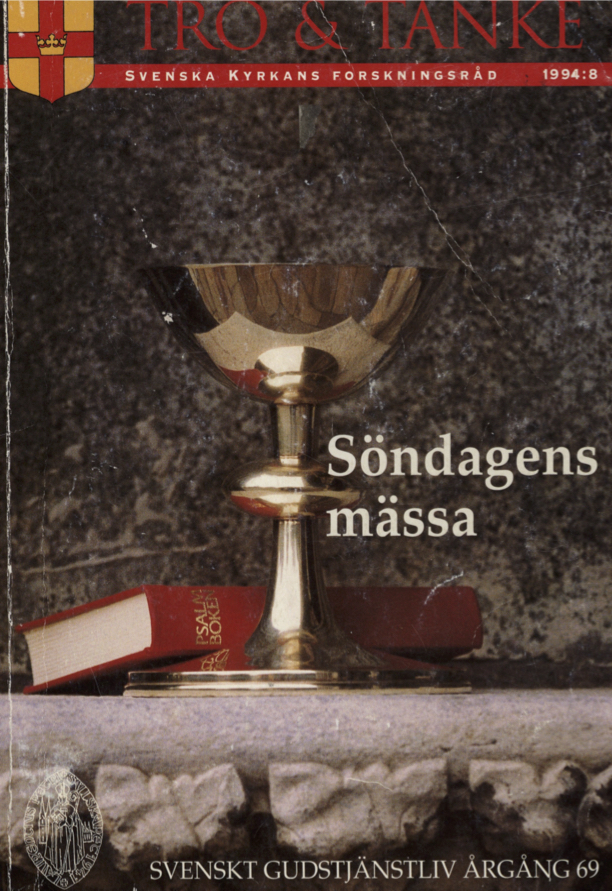Tackoffer, kommunion, solidaritet - om olika nattvardsmotiv
Abstract
The Eucharist contains sacrificial aspects (a movement from man to God) as well as sacramental aspects (a movement from God to man), but they are held together in the person of Christ, by the believers confessed to be true man as well as true God. In the past, Lutherans laid the main stress on sacramental aspects focusing on communion rather exclusively, whereas sacrificial aspects were treated more shyly: there was always a fear of converting the divine act of grace to a meritorious human deed which, they thought, had actually occurred within Roman-Catholic tradition. At the same time, Lutherans eagerly defended a realistic interpretation of the sacramental presence of Christ in the natural elements of bread and wine, rejecting the symbolic interpretations made by Zwinglians and Calvinists.
Recent ecumenical and liturgical development has furthered a common understanding of the Eucharist making many old controversies obsolete. A distinguished exposé of this new understanding is given in the Eaith and Order paper no. Ill, 1982, the so-called Lima report, "Baptism, Eucharist and Ministry". The way in which the concept of memorial (anamnesis) is interpreted in the light of modern biblical research is especially illuminating. Having its background in the Jewish passover celebration, it implies the representation and "present efficacy of Gods salvific work when it is celebrated by Gods people in a liturgy". "Christ himself with all that he has accomplished for us and for all creation ... is present in this anamnesis, granting us communion with himself."
Anamnesis thus gives the key to a new understanding of the "real presence" of Christ in the eucharistic act as well as of its sacrificial aspects. "The eucharist is the great sacrifice of praise", "the great thanksgiving to the Father for everything accomplished in creation, redemption and sanctification". How is this sacrifice of praise related to Christ’s expiating sacrifice? Christ’s sacrifice on the cross is "unique and can neither be repeated nor prolonged", but in the memorial celebrated in the eucharistic act it is present in its actual efficacy and pleaded before God in prayer and intercession. So "the eucharist is the sacrament of the unique sacrifice of Christ, who ever lives to make intercession for us". By being included in Christ’s constant intercession for the world, the sacrifice of praise, the memorial, and the prayers and intercessions of the Church run no risk of being interpreted in a meritorious way. The prayers, indeed, are expressly offered in the name of Christ, "through Jesus Christ, our Lord". In its prayers and intercessions, the Church "speaks on behalf of the whole creation". For the individual believer, the active participation in the liturgy implies the voluntary self-offering before God.
The communion is above all a communion with Christ and through him with God, a communion made possible through the invocation of the holy Spirit - the epi’klesis appearing in early church liturgies and within the Eastern Orthodox tradition but missing in traditional Western liturgies, has been adopted by most Western churches, through ecumenical inspiration. During communion, the believer meets a true gospel in the deeply personal words: "given for you", "shed for you", and is offered the possibility of a new beginning in spite of his/her insufficiencies before the high demands of God; indeed, "the remission of sins" is expressly mentioned in the words of institution. Thoughts of "mystical unity" are furthered by the simple act of communion and should not be objected to; even if Lutheranism has been rather shy before such aspects, it was in fact recognized by Orthodox Lutheran theologians.
The Lima report especially stresses the communion of the faithful and the solidarity with all humankind. "The sharing in one bread and the common cup in a given place demonstrates and effects the oneness of the sharers with Christ and with their fellow sharers in all times and places." - "The eucharistic celebration demands reconciliation and sharing among all those regarded as brothers and sisters in one family of God and is a constant challenge in the search for appropriate relationships in social, economic and political life ... All kinds of injustice, racism, separation and lack of freedom are radically challenged when we share in the body and blood of Christ."
In Lutheran tradition, the altar ring where the believers kneeling receive communion is a telling liturgical sign demonstrating a basic equality between people, and questioning social rankings. The breaking and sharing of the sacramental bread is a sign of the unity of all believers within the body of Christ, and a challenge to share the physical bread with all those starving in the world of today. The Lima report points to a further challenge: "As Jesus went out to publicans and sinners and had table-fellowship with them during his earthly ministry, so Christians are called in the eucharist to be in solidarity with the outcast ..."
Explicating diverse aspects of the Eucharist, the Lima report finally dwells upon "the eucharist as a meal of the Kingdom". The andmnesis celebrated in the eucharistic act includes antecipation as well as representation. "As it is entirely the gift of God, the eucharist brings into the present age a new reality which transforms Christians into the image of Christ and therefore makes them his effective witnesses. The eucharist is precious food for missionaries, bread and wine for pilgrims on their apostolic journey."
Downloads
Publicerad
Nummer
Sektion
Licens
© författarna, Laurentius Petri Sällskapet för svenskt gudstjänstliv samt Artos & Norma bokförlag. Det är tillåtet att kopiera och använda material ur Svenskt Gudstjänstliv för forskningsändamål om källan anges. För övriga ändamål kontakta respektive artikelförfattare samt förlaget. Särskilda restriktioner kan gälla för bildmaterial.


